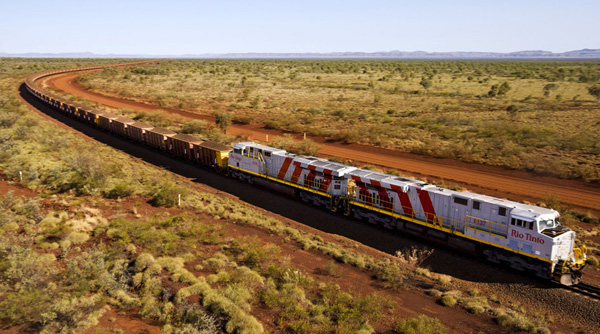
Credit: Christian Sprogoe Photography
Rio Tinto did not make a song and dance when it started mining at its Silvergrass project in Australia’s Pilbara in August.
After getting flak from politicians and competitors alike about its aggressive expansion strategy, the Melbourne-based giant probably thought it prudent not to.
At the moment Silvergrass’s high grade ore is being shipped to “retain the integrity and quality” of Rio’s flagship Pilbara blend, CEO Sam Walsh told investors with the release of the company’s half-year results.
The project hasn’t received board approval yet although CEO Sam Walsh sounded pretty confident that the go-ahead would come early in 2016.
Silvergrass has a lot going for it. It’s cheap to build and expected to be completed at the lower end – or below – its $700 million to $1 billion forecast costs (a steal compared to a Rinehart’s Roy Hill or Anglo’s Minas Rio).
Capacity of over 20 million tonnes per year would easily plug into Rio’s existing Pilbara infrastructure and the project could be completed in just nine months.
Just in time for Rio to hit (or likely exceed) its target of 360 million tonnes per year in 2017 and come very close to overtaking Vale, which is cutting production in Brazil.
Thanks to breakeven costs of less than $30 a tonne, Rio Tinto (and BHP for that matter) could afford to add more tonnage.
Or perhaps cooler heads will prevail. Michelle Lopez, senior investment manager Aberdeen Asset Management, told the Australian Financial Review the miner “could look to use production from Silvergrass to replace some of its higher-cost iron ore, which it could shut down if market dynamics don’t change”:
“We would expect them to be rational, and use it to replace higher-cost ore rather than add more product into an oversupplied market. Silvergrass is more marginal [as a growth option] but a premium product.”
“That does not imply that Rio would change its production guidance for the next two years. But it means that from late 2017, when Silvergrass would be starting up, Rio will be pushed to look at the price to judge how quickly it gets to its ultimate production target of 360 million tonnes.
Iron ore fell to a fresh near-decade low on Thursday with the Northern China 62% Fe import price including freight and insurance (CFR) dropping to $40.30 a tonne, down 11.5% in just one month.
After a strong recovery from its July low, the steelmaking raw material has been on a relentless decline since mid-October. Losses so far this year come to more than 43%. Today’s price compare to $190 a tonne hit February 2011 and an average of $135 a tonne in 2013 and $97 last year.
5 Comments
Wake.Up
`dumb `dumb dumb `dumb ‘Dumb!
Wake.Up
Some body wants to be the king of the damaged market!
Wake.Up
A SuperCEO envisioned his kingdom. He stood in front of the Golden Iron hill and set his target to conquer 500 km beyond that hill. Once he and his troops got to the top of the Golden Iron hill, they saw a great canyon just about 50 km in front of them. Since the SuperCEO already told his followers the target to conquer and to show his troops he never change his mind once a decision was made, he decided to force his entire troops to jump into the canyon in hope that some of his troops will survive.
PaoloUSA
BHP on the annual report ending FY2015 posted an underlying EBIT for the iron ore business of 6.932 bil USD down from 12.102 bil USD of FY 2014 (page 35).
“WAIO unit cash costs (excluding freight and royalties) declined by 31 per cent to US$19 per tonne, underpinned by reductions in labor, contractor and maintenance costs, lower diesel prices and a stronger US dollar against the Australian dollar”, shipping has decreased too. All variable cost elements (diesel, shipping and usd/ausd rates).
So far the average realized price for FY2015 (june 2014-June2015) still mutes a bit the underlying reality, we are not yet at stable below 40 market level; should it become stable expect a drastic drop in optimism.
nick kelly
You have to work backwards and restrict over supply of the end product- steel .
It is barely an exaggeration to say that the Chinese will run a steel mill for the fun of it.
But to be dispense with comedy- they will very definitely run a mill at a loss, and hundreds are doing that right now. Same with aluminum, but concrete not so much because it isn’t exported.
Until importers of Chinese steel take action, the flood will simply continue, the steel price will drop and the Chinese mills will need cheaper iron ore. “if we run at loss- how about you too?”
It’s not an economic driver- it’s political. The Chinese Communist Party and its connected banks have the will and reserves to keep the mills running.
But you could make the case for let’s say the UK, to let your steel makers go bust and if these guys are crazy enough to produce dirt cheap steel, just fecking let them. Use the steel to make something, and use the money you were thinking of using to subsidize your steel makers on research and loans for your steel users. It’s probably a better long-term strategy anyway
Take the Austin Mini- I estimate very roughly that about 1.5 % of the price is steel. If the guy orders leather seats it’s probably more money. And if you let the crazy Chinese supply you with steel cheaper than you can make it, you save a few quid on the Mini and god knows how much in air pollution.
Can you hear folks saying: once they’ve killed off the competition they’ll raise the price?
Maybe twenty years from now- in the meantime if anyone wants to jump back into the steel business, there is a world of capacity for sale.
.